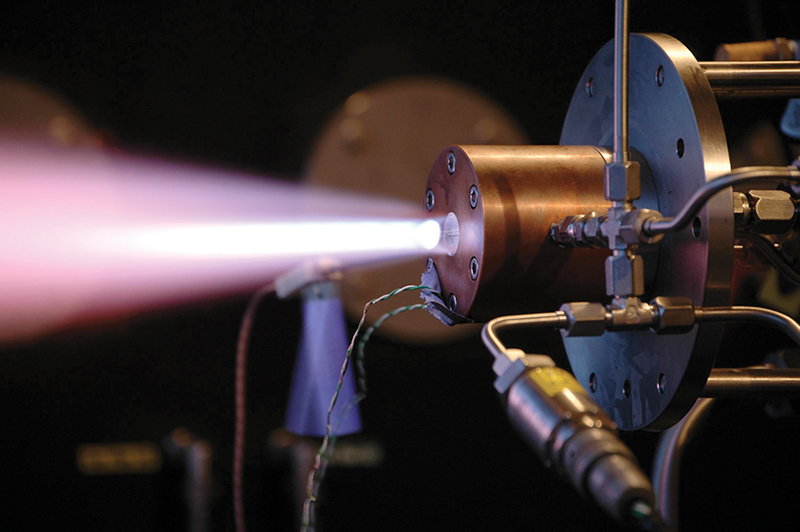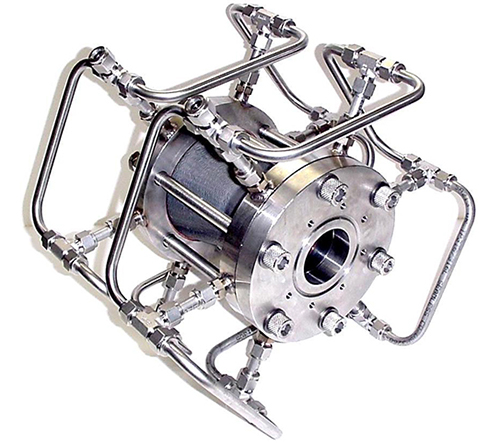
The Cutting Edge of High-Temperature Composites
Originating Technology/NASA Contribution
NASA’s Ultra-Efficient Engine Technology (UEET) program was formed in 1999 at Glenn Research Center to manage an important national propulsion program for the Space Agency. The UEET program’s focus is on developing innovative technologies to enable intelligent, environmentally friendly, and clean-burning turbine engines capable of reducing harmful emissions while maintaining high performance and increasing reliability.
Seven technology projects exist under the program, with each project working towards specific goals to provide new technology for propulsion. One of these projects, Materials and Structures for High Performance, is concentrating on developing and demonstrating advanced high-temperature materials to enable high-performance, high-efficiency, and environmentally compatible propulsion systems. Materials include ceramic matrix composite (CMC) combustor liners and turbine vanes, disk alloys, turbine airfoil material systems, high-temperature polymer matrix composites, and lightweight materials for static engine structures.
Partnership
Hyper-Therm High-Temperature Composites, Inc. (Hyper-Therm HTC), is a worldwide leader in producing high-temperature ceramic composite materials. In the mid-1990s, the Huntington Beach, California-based company created a silicon-doped boron nitride (BN) fiber coating for advanced CMCs. This development was geared towards demanding applications that require increased durability and longevity, as well as demanding environments, such as space.
By participating in NASA’s Small Business Innovation Research (SBIR) program with Glenn, Hyper-Therm HTC is helping the UEET program reach its goals to “develop and hand off revolutionary turbine engine propulsion technologies that will enable future-generation vehicles over a wide range of flight speeds.” Hyper-Therm HTC’s ceramic composites are also being evaluated by other NASA programs that require improved materials for next-generation launch and flight vehicles.
Additionally, Hyper-Therm HTC was contracted (SBIR) by Glenn’s neighbor to the south, Marshall Space Flight Center, to devise a unique and cost-effective methodology for manufacturing axisymmetric ceramic composite structures. According to the company, this project helped to facilitate the world’s first actively cooled, continuous fiber-reinforced silicon carbide (SiC)-matrix composite thrust chambers for liquid rocket propulsion systems. These propulsion devices were designed to be cooled with cryogenic liquid hydrogen, to provide protection from severe, high-temperature combustion environments (greater than 6,500 °F liquid hydrogen/oxygen). Hot-fire testing of the devices was performed by Glenn.
By working with NASA’s Glenn and Marshall centers, as well as other branches of government, Hyper-Therm HTC was able to further develop and optimize its composite technology for government and commercial aerospace, plus commercial industrial applications.
Product Outcome
Hyper-Therm HTC has experienced sales in excess of $4 million, thanks to its advanced composite materials, coatings, and components. The technology has been folded into everything from hypersonic airframe and thermal re-entry structures, to turbine disks, laser mirror substrates, heat-engine devices, ballistic penetrators, micro-rotary cutting tools, and free-standing refractory metal components for nuclear, medical, and materials research applications.
The cutting-edge composites are produced via isothermal/isobaric and forced-flow chemical vapor infiltration (CVI) processing techniques. The company’s most popular high-temperature structural material systems are composed of carbon and SiC fiber reinforcements in a CVI SiC matrix. Available fiber coatings include silicon-doped BN, pyrolytic BN, pyrolytic carbon (PyC), and duplex PyC-B4C, all of which have been developed to impart an optimum balance of strength, fracture toughness, and strain-to-failure.
For applications demanding increased durability and life in aggressive environments, Hyper-Therm HTC offers its multilayer SiC fiber coating system and its pseudo-porous SiC system. The multilayer fiber coating system is composed of very thin (about 100 nanometers), weakly bonded layers of stoichiometric SiC and was developed to mitigate the inherent problems of oxidation and moisture instability plaguing currently available PyC and BN fiber coatings. (In its work with NASA, the company achieved a hundredfold improvement in moisture stability over standard, low-temperature-derived BN fiber coatings.) The pseudo-porous fiber coating system is composed of a thin (less than 1 micrometer), breakable monolayer network of porous SiC—also developed to mitigate the associated problems with PyC and BN.
Looking ahead, the stirring demand for stronger-but-lighter, high-temperature, cost-effective materials will fortify Hyper-Therm HTC’s business opportunities in existing markets, as well as new ones.

Hyper-Therm High-Temperature Composites, Inc., is developing advanced composite materials for a variety of high-temperature aerospace applications, including this advanced rocket propulsion thrust chamber.

The stronger, more stable composite materials, coatings, and components developed with NASA Small Business Innovation Research funding could also be used for other high-temperature applications, such as hypersonic aircraft thermal structures.













